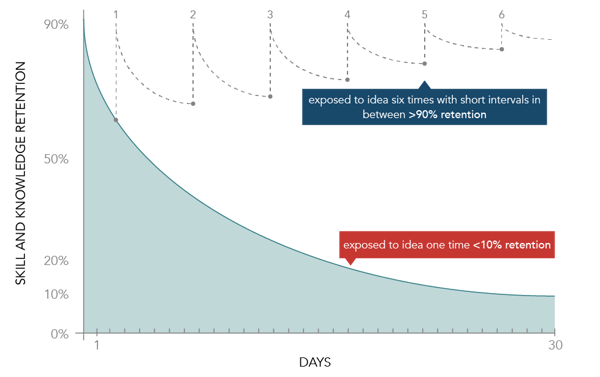Reinforcement has been a trend in the world of sales training for a while now. All the research data in sales training—and learning and development in general—supports the need for robust reinforcement.
But it’s still not happening often enough.
According to Aberdeen, fewer than half (44%) of companies formally follow-up initial sales training with reinforcement. At the same time, the companies that do reinforce training see 20% more sellers achieve sales quotas.
9 Types of Sales Training Reinforcement
|
With no reinforcement, it usually takes just a few weeks before sellers say:
- I don't remember what was covered in the sales training program
- I don’t know enough to use the tools and apply the advice
- I didn't get enough practice to feel confident enough to give it a try
- I tried something and it didn’t work…I'm not sure if it just doesn't work or if I did it wrong
- I'm pretty sure the powers that be don't remember this was a priority anyway
- No one's going to check that I'm using the new skills
- I'll just go back to what I was doing before
As much as participants may have loved the program, it’s the rare seller who goes home and curls up by the fire with a simmering cup of hot chocolate (with marshmallows) and reviews their sales training binder three times a week.
With event-only training, after short-term bumps in sales improvement, sellers forget learned skills and knowledge, forget how inspired and motivated they were, and learning effectiveness decreases.
According to the Forgetting Curve, up to 77% of learning is forgotten within 6 days.
Reinforcement is a must.
The best way to drive learning retention is through spaced repetition and interval reinforcement. When a participant is exposed to an idea one time, there's less than 10% retention. However, when they’re exposed to an idea six times with short intervals in between, you can achieve greater than 90% retention.

Reinforcement comes in the way of:
- Concept reinforcement
- Expectation reinforcement
- Motivation enhancement
- Complementary learning
- Action planning and review
- Practice and feedback
- Technology embedding
Build Sales Skills that Stick
Adult learning is an ongoing process. Only through repetition and practice will your sales team internalize sales skills training and consistently put it to use.
You can get the results you want by keeping learning fresh with:
- Virtual, instructor-led training (VILT), webinars, and teleseminars which are great for a geographically diverse workforce. They offer an interactive experience that allow sellers to ask questions, receive guidance on real-life situations, reinforce key concepts, and learn advanced skills.
- Online training and lessons can be made available on-the-job when the team needs to reinforce key topics and support complementary learning.
- Ongoing live workshops allow sellers to dig deep into specific areas. They can practice real situations, learn advanced skills, build the next skill, and keep previous training top-of-mind.
- Mobile and email reinforcement provide action reminders and tips to help the team put the new sales skills to practice. It drives knowledge retention and guides seller behavior. It can also enhance eLearning engagement and assist with analysis and coaching.
- Job aids and tools, such as planners, checklists, playbooks, frameworks, and conversation guides, can help sellers take the learning from the classroom and apply it on-the-job.
- Simulations and gaming can be done live or asynchronous. It can be a fun and engaging experience to learn and put new skills to the test.
- Regular role playing with sales managers, coaches, or through VILT offer much needed practice and feedback.
- Embedding technology so training methodology, tools, and additional learning occur throughout the seller’s regular workflow. For example, if your sellers have gone through sales negotiation training, embed the sales negotiation planner in your CRM with an eLearning lesson walking them through how to use it.
- Sales coaching is a key component of reinforcement. Coaches should meet regularly with sellers to help them develop goal and action plans, hone skills, stay motived, and stay on task and on target.
It would be great if sustainable improvement in sales skills and real changes in behaviors could be accomplished in just one day. But that’s not the way adults learn, and it’s not the way to change behavior.
For the best sales training success, incorporate a robust reinforcement program into your change initiatives.






